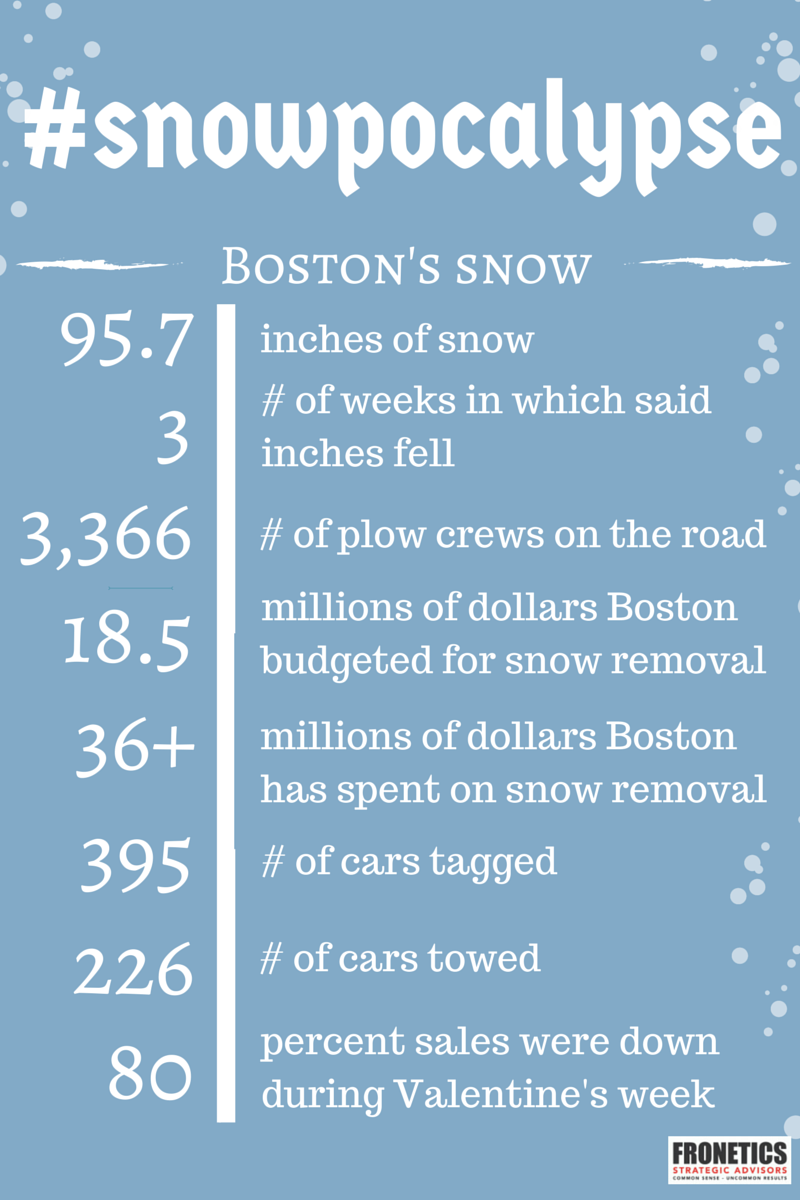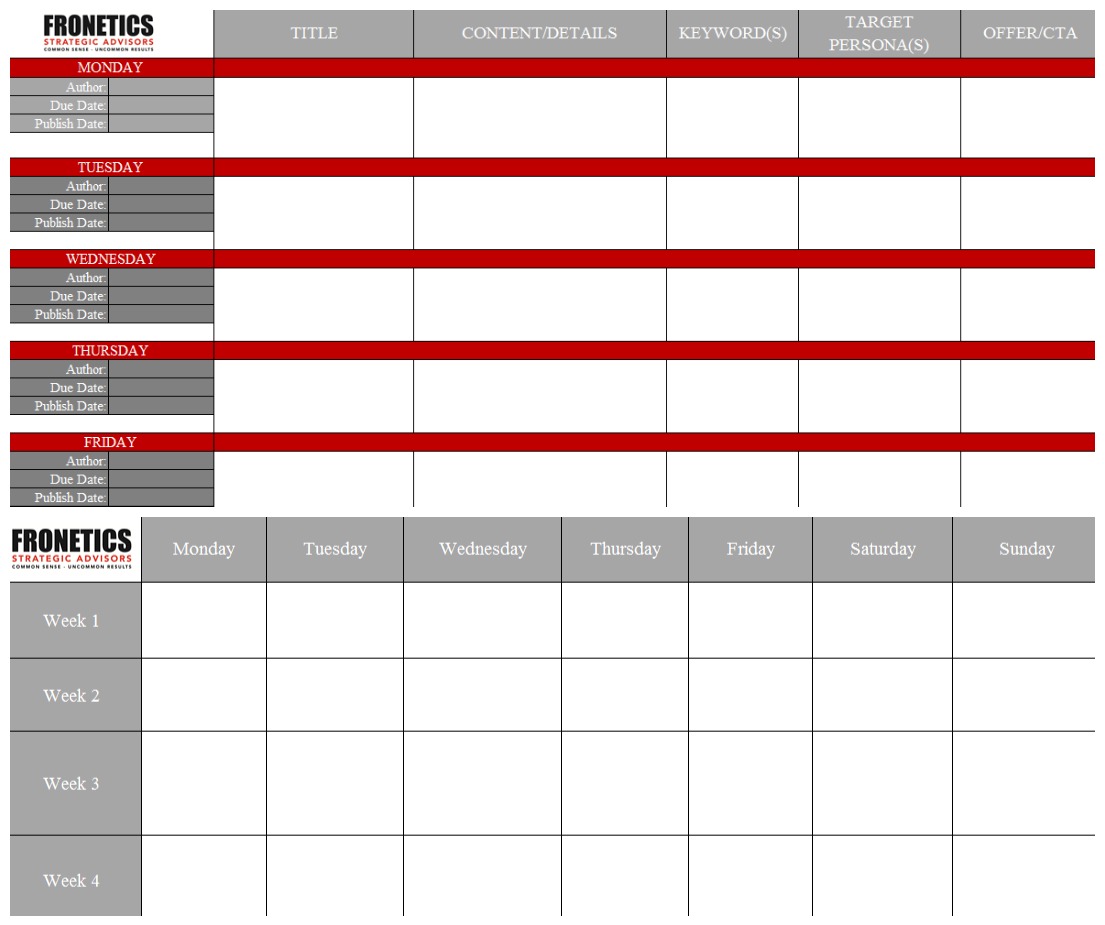![Boston’s snow logistics [Infographic]](https://www.fronetics.com/wp-content/uploads/2024/10/Boston-snow-logistics-800x675.png)
by Fronetics | Feb 17, 2015 | Blog, Current Events, Logistics, Strategy
The logistics of Boston’s snow #snowpocalypse
For the past three weeks we have been pretty much like this: shovel, snow blow, tackle commutes, juggle school cancellations, repeat.
Charlotte Wilder expressed the sentiments of many when she penned A Breakup Letter to Snow From the City of Boston. 95.7 inches of snow within 3 weeks is a lot of snow. The sheer amount of snow has forced the city’s public transportation to cancel operations. Schools have been cancelled, several for two weeks or more. Cars have been buried. Businesses have been forced to close. Businesses that have remained opened have realized dismal sales. Boston has opened snow farms and has purchased melting trucks. National Guard troops have been called in to help remove snow. #snowpocalypse 2015.

The snow has complicated the logistics of life. As we, individuals and businesses, complain about the economic, physical, and mental challenges associated with the snow it is important to put things into perspective. NPR’s Barbara Howard’s Blizzard of Perspective does just that.
![Why you need an editorial calendar for your blog [Free template]](https://www.fronetics.com/wp-content/uploads/2024/10/editorial-calendar-template-1080x675.jpg)
by Fronetics | Feb 16, 2015 | Blog, Content Marketing, Marketing, Strategy
An editorial calendar is an invaluable tool; it will drive success.
When it comes to blogging, you may know what outcomes your company is looking to achieve, but do you have a specific plan to get there? We know post and pray isn’t an effective strategy.
Enter the editorial calendar. The use of an editorial calendar gives structure to your blogging efforts. Think of it as both a commitment to your potential customers and built-in accountability for your overall strategy.
The editorial calendar is a dynamic, internal document that will help your team determine what activities you’ll focus on (and when they’ll be completed) in order to connect and engage potential customers with your blog content. Presented in a calendar-like format, an editorial calendar makes it easy to visualize your marketing strategy, ensuring consistently scheduled blog posts and a diversity of topics. Beyond scheduling blog posts, the use of an editorial calendar keeps other essential considerations front of mind. Including related information, such as keyword assignments, target persona(s), and associated promotions or calls to action, will make your editorial calendar an indispensable guide to your blogging success.
We’ve created an editorial calendar template to guide your blogging efforts. Designed to keep you on track as you develop content that will attract and engage your prospects and customers, our template (it’s free) will help you map out your content in a strategic manner, maximize productivity, and keep you organized.


![Why you need an editorial calendar for your blog [Free template]](https://www.fronetics.com/wp-content/uploads/2024/10/editorial-calendar-template-1080x675.jpg)
by Fronetics | Feb 16, 2015 | Blog, Content Marketing, Marketing, Strategy
An editorial calendar is an invaluable tool; it will drive success.
When it comes to blogging, you may know what outcomes your company is looking to achieve, but do you have a specific plan to get there? We know post and pray isn’t an effective strategy.
Enter the editorial calendar. The use of an editorial calendar gives structure to your blogging efforts. Think of it as both a commitment to your potential customers and built-in accountability for your overall strategy.
The editorial calendar is a dynamic, internal document that will help your team determine what activities you’ll focus on (and when they’ll be completed) in order to connect and engage potential customers with your blog content. Presented in a calendar-like format, an editorial calendar makes it easy to visualize your marketing strategy, ensuring consistently scheduled blog posts and a diversity of topics. Beyond scheduling blog posts, the use of an editorial calendar keeps other essential considerations front of mind. Including related information, such as keyword assignments, target persona(s), and associated promotions or calls to action, will make your editorial calendar an indispensable guide to your blogging success.
We’ve created an editorial calendar template to guide your blogging efforts. Designed to keep you on track as you develop content that will attract and engage your prospects and customers, our template (it’s free) will help you map out your content in a strategic manner, maximize productivity, and keep you organized.



by Fronetics | Feb 12, 2015 | Blog, Content Marketing, Marketing, Strategy

7 steps to a blogging strategy for your business.
Blogging has proved to be a successful marketing strategy for many companies. In fact, a full 82 percent of companies who blog daily day have acquired a customer from their blog. Freight logistics company Cerasis acquired 98 new customers by leveraging their blog and digital strategy.
What does it take to attract prospects and acquire customers? Strategy. A 2014 study of B2B marketers found that companies who have a documented content strategy in place are more likely to consider their efforts to be effective than companies who do not have a documented strategy in place (60 percent vs. 11 percent).
Here are 7 steps to follow to develop a blogging strategy for your business.
1. Understand the ‘Why’.
The first step in the development of your blogging strategy will serve as the foundation for all remaining elements. Defining the purpose of your blogging activities and communicating them to your team will create a clear path to successful implementation. Understanding the purpose of your blogging activities means being able to answer two important questions: Why has your company decided to blog? What is it hoping to gain? Setting the strategy for your blog starts with understanding the reasons and motivations for prioritizing blogging as a marketing strategy.
2. Let your ideal customers define content.
Content will be the backbone of your blogging operation. Since you are likely targeting ideal customers with this content in order to convert them to leads, it stands to reason that you should look to them for content inspiration. Building out hypothetical profiles of your ideal customers will allow you to answer important questions such as their pain points, challenges, demographics, and job duties. Use what you know about the buying and researching behaviors of your ideal customers to craft relevant and interesting content they’d likely be searching for. Above all, publish nothing less than your most quality content. Part of building your reputation as a trusted industry thought leader is setting – and continuing – to meet expectations. You’re better off missing one day of a blog post than phoning in something that has the potential to undermine the credibility of your company.
Keywords signal to search engines when there’s a match between your content and the search term of a user. Similar to crafting content with your ideal customer in mind, keywords should be tailored to phrases your ideal customers use to research and buy. Determine which keywords you’ll be targeting and then draft a list of 5-10 keywords and associated long-tail keywords you will include in blog content.
4. Identify content distribution activities and platforms for promotion.
Once you’ve determined strategy for content creation and optimization, it’s time to make a plan to get your quality content in front of potential customers. It’s not enough to just post and pray that you’ll be found – you should actively distribute and promote blog content. Fortunately, the proliferation of social media has made it easier for companies to reach their target audiences, but not without competition. Reusing blog posts and repackaging content in different forms – such as infographics, summary tweets, & photos – will help break through the noise of competitors.
5. Assign responsibility.
Decide what your day-to-day blogging operations will look like. Who will be accountable for each function of your blogging strategy? The size and resource availability of your organization is likely to determine how centralized blogging responsibilities will be. When thinking about responsibilities, consider tasks beyond just writing posts; responsibility for tasks such as publishing and promoting content, drafting an editorial calendar, and analyzing data will all need to be assigned.
6. Maintain an editorial calendar.
Analogous to a roadmap, an editorial calendar will guide your blogging activities and give you a big picture look at where you’re headed and how you’re getting there. It also serves to hold those with blog-related responsibilities accountable to a publishing schedule. And while it’s true that the frequency of blog posts can be linked to an increase in website traffic, stepping outside of what you can reasonably commit to is a recipe for disaster.
Use your editorial calendar to set the number of blog posts you’ll publish each week to ensure posts are published with consistency and regularity. That not only establishes routine for your team, but also for your readers. Get started now with this template for creating your own editorial calendar.
7. Measure, analyze, adapt, and repeat.
Determine what your blogging success will look like and use relevant tools to regularly track and monitor metrics. Include metrics from all platforms of distribution, not just website page views or traffic. Think in terms of retweets, follows, likes, and subscribers. Set, review, and revisit goals consistently. Modify approaches that aren’t working. This on-going analysis keeps blogging efforts nimble, which is particularly helpful when outside factors make changes in blogging objectives necessary.
Develop and implement a well-thought-out blogging strategy. Using quality blog content to find, connect, and engage potential customers online can quickly become your powerhouse marketing activity.
Interested in learning more about how your business can develop a winning blogging strategy? We can help. We are a consulting firm focused on inbound marketing and strategy.


by Fronetics | Feb 12, 2015 | Blog, Content Marketing, Marketing, Strategy

7 steps to a blogging strategy for your business.
Blogging has proved to be a successful marketing strategy for many companies. In fact, a full 82 percent of companies who blog daily day have acquired a customer from their blog. Freight logistics company Cerasis acquired 98 new customers by leveraging their blog and digital strategy.
What does it take to attract prospects and acquire customers? Strategy. A 2014 study of B2B marketers found that companies who have a documented content strategy in place are more likely to consider their efforts to be effective than companies who do not have a documented strategy in place (60 percent vs. 11 percent).
Here are 7 steps to follow to develop a blogging strategy for your business.
1. Understand the ‘Why’.
The first step in the development of your blogging strategy will serve as the foundation for all remaining elements. Defining the purpose of your blogging activities and communicating them to your team will create a clear path to successful implementation. Understanding the purpose of your blogging activities means being able to answer two important questions: Why has your company decided to blog? What is it hoping to gain? Setting the strategy for your blog starts with understanding the reasons and motivations for prioritizing blogging as a marketing strategy.
2. Let your ideal customers define content.
Content will be the backbone of your blogging operation. Since you are likely targeting ideal customers with this content in order to convert them to leads, it stands to reason that you should look to them for content inspiration. Building out hypothetical profiles of your ideal customers will allow you to answer important questions such as their pain points, challenges, demographics, and job duties. Use what you know about the buying and researching behaviors of your ideal customers to craft relevant and interesting content they’d likely be searching for. Above all, publish nothing less than your most quality content. Part of building your reputation as a trusted industry thought leader is setting – and continuing – to meet expectations. You’re better off missing one day of a blog post than phoning in something that has the potential to undermine the credibility of your company.
Keywords signal to search engines when there’s a match between your content and the search term of a user. Similar to crafting content with your ideal customer in mind, keywords should be tailored to phrases your ideal customers use to research and buy. Determine which keywords you’ll be targeting and then draft a list of 5-10 keywords and associated long-tail keywords you will include in blog content.
4. Identify content distribution activities and platforms for promotion.
Once you’ve determined strategy for content creation and optimization, it’s time to make a plan to get your quality content in front of potential customers. It’s not enough to just post and pray that you’ll be found – you should actively distribute and promote blog content. Fortunately, the proliferation of social media has made it easier for companies to reach their target audiences, but not without competition. Reusing blog posts and repackaging content in different forms – such as infographics, summary tweets, & photos – will help break through the noise of competitors.
5. Assign responsibility.
Decide what your day-to-day blogging operations will look like. Who will be accountable for each function of your blogging strategy? The size and resource availability of your organization is likely to determine how centralized blogging responsibilities will be. When thinking about responsibilities, consider tasks beyond just writing posts; responsibility for tasks such as publishing and promoting content, drafting an editorial calendar, and analyzing data will all need to be assigned.
6. Maintain an editorial calendar.
Analogous to a roadmap, an editorial calendar will guide your blogging activities and give you a big picture look at where you’re headed and how you’re getting there. It also serves to hold those with blog-related responsibilities accountable to a publishing schedule. And while it’s true that the frequency of blog posts can be linked to an increase in website traffic, stepping outside of what you can reasonably commit to is a recipe for disaster.
Use your editorial calendar to set the number of blog posts you’ll publish each week to ensure posts are published with consistency and regularity. That not only establishes routine for your team, but also for your readers. Get started now with this template for creating your own editorial calendar.
7. Measure, analyze, adapt, and repeat.
Determine what your blogging success will look like and use relevant tools to regularly track and monitor metrics. Include metrics from all platforms of distribution, not just website page views or traffic. Think in terms of retweets, follows, likes, and subscribers. Set, review, and revisit goals consistently. Modify approaches that aren’t working. This on-going analysis keeps blogging efforts nimble, which is particularly helpful when outside factors make changes in blogging objectives necessary.
Develop and implement a well-thought-out blogging strategy. Using quality blog content to find, connect, and engage potential customers online can quickly become your powerhouse marketing activity.
Interested in learning more about how your business can develop a winning blogging strategy? We can help. We are a consulting firm focused on inbound marketing and strategy.

![Boston’s snow logistics [Infographic]](https://www.fronetics.com/wp-content/uploads/2024/10/Boston-snow-logistics-800x675.png)


![Why you need an editorial calendar for your blog [Free template]](https://www.fronetics.com/wp-content/uploads/2024/10/editorial-calendar-template-1080x675.jpg)



